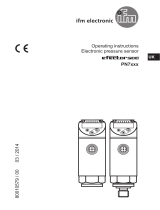
2
Contents
1 Preliminary note ���������������������������������������������������������������������������������������������������3
1�1 Symbols used ������������������������������������������������������������������������������������������������3
2 Safety instructions �����������������������������������������������������������������������������������������������4
3 Functions and features ����������������������������������������������������������������������������������������5
3�1 Applications ���������������������������������������������������������������������������������������������������5
4 Function ���������������������������������������������������������������������������������������������������������������5
4�1 Operating modes �������������������������������������������������������������������������������������������6
4�2 Communication, parameter setting, evaluation ���������������������������������������������7
4�3 Switching function ������������������������������������������������������������������������������������������7
4�4 Analogue function ������������������������������������������������������������������������������������������8
4�5 IO-Link �����������������������������������������������������������������������������������������������������������9
4�5�1 General information ������������������������������������������������������������������������������9
4�5�2 Functions only available via IO-Link communication ��������������������������10
5 Installation����������������������������������������������������������������������������������������������������������10
6 Electrical connection ������������������������������������������������������������������������������������������ 11
7 Operating and display elements ������������������������������������������������������������������������12
8 Menu ������������������������������������������������������������������������������������������������������������������13
8�1 Menu structure: main menu �������������������������������������������������������������������������13
8�2 Explanation of the menu ������������������������������������������������������������������������������14
8�2�1 Explanation of menu level 1 ���������������������������������������������������������������14
8�2�2 Explanation of menu level 2 ���������������������������������������������������������������14
9 Parameter setting ����������������������������������������������������������������������������������������������15
9�1 Parameter setting in general �����������������������������������������������������������������������15
9�2 Define operating mode (optional) ����������������������������������������������������������������18
9�3 Configure display (optional) ������������������������������������������������������������������������� 18
9�4 Set output signals ����������������������������������������������������������������������������������������18
9�4�1 Set output functions ���������������������������������������������������������������������������� 18
9�4�2 Define switching limits for the hysteresis function ������������������������������19
9�4�3 Define switching limits for the window function ����������������������������������19
9�4�4 Scale analogue value �������������������������������������������������������������������������19
9�5 User settings (optional) ��������������������������������������������������������������������������������20
9�5�1 Set delay time for the switching outputs ���������������������������������������������20























